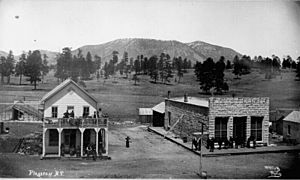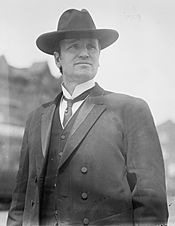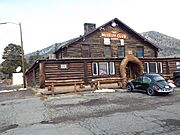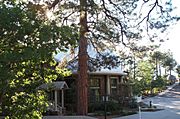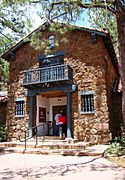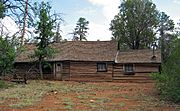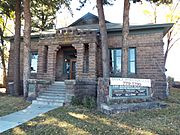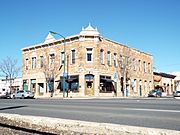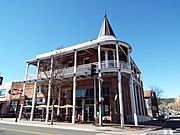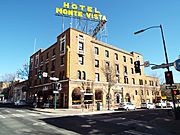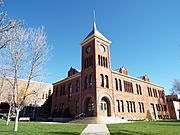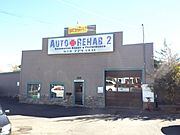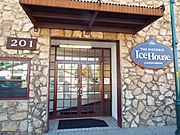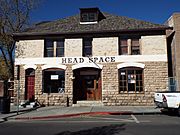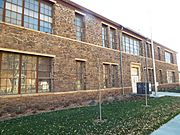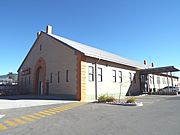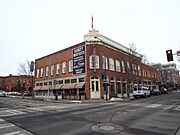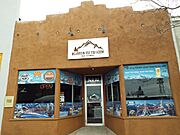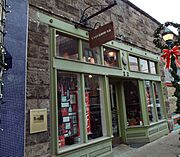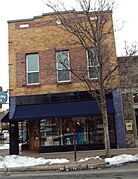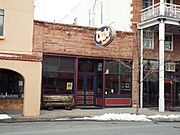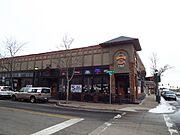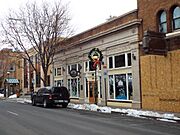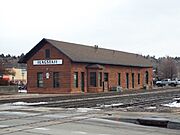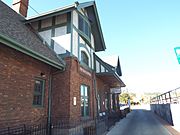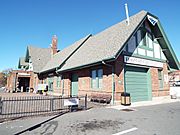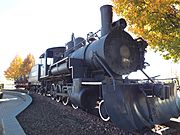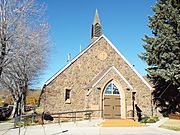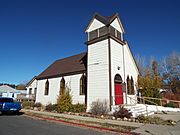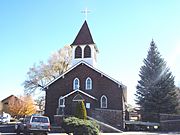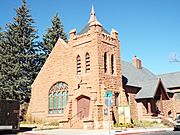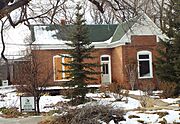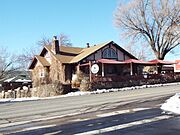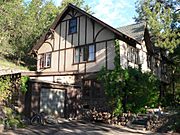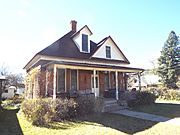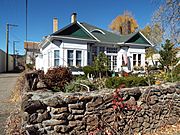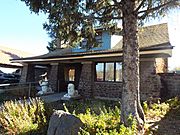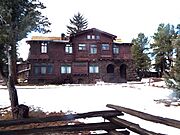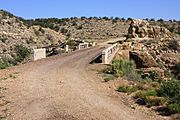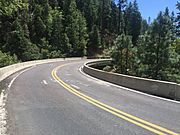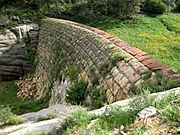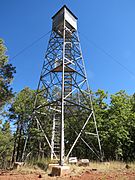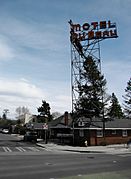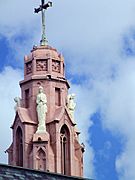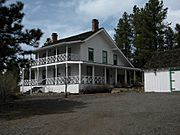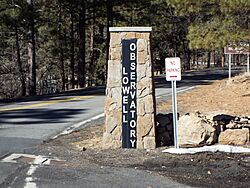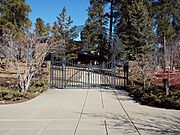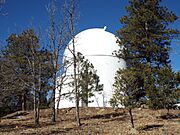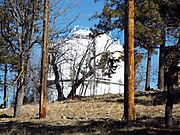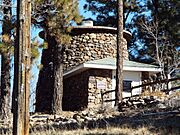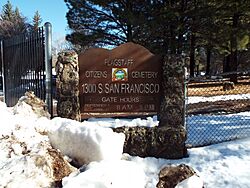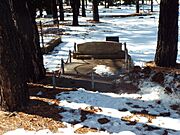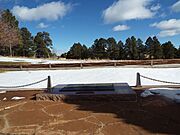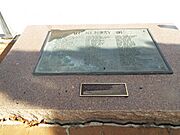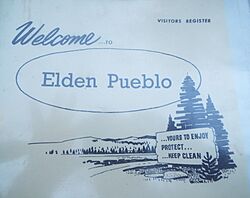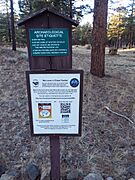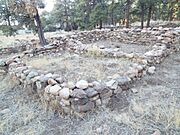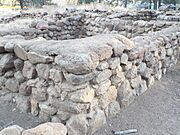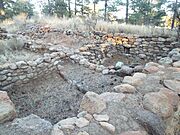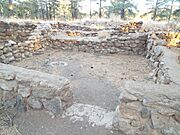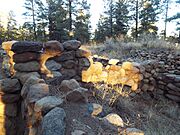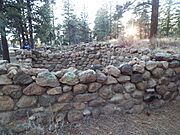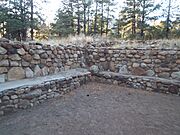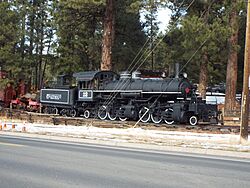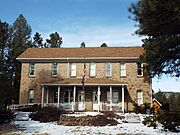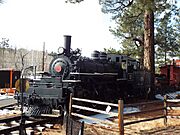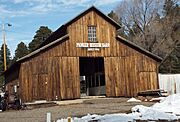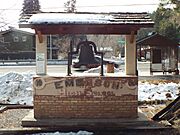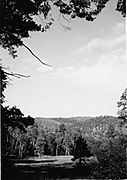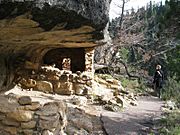List of historic properties in Flagstaff, Arizona facts for kids
Quick facts for kids
List of historic properties
in Flagstaff. Arizona |
|
|---|---|

Flagstaff Route 66 sign
|
|
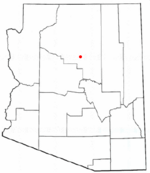
Map of Flagstaff in the Coconino County of the state of Arizona
|
Welcome to Flagstaff, Arizona! This article will take you on a tour of some amazing old buildings, homes, bridges, and monuments in the city. Many of these special places are listed in the National Register of Historic Places (NRHP). This means they are officially recognized as important parts of history. You'll also see pictures of the historic Two Spot Logging Train and the Flagstaff Station.
Flagstaff's Story
The first non-Native-American person to settle here was Thomas F. McMillan. His cabin is now a historic site. The Santa Fe Railroad built a town nearby and named it Flagstaff. In the 1880s, the town got its first post office. The name "Flagstaff" comes from a fun story. On July 4, 1855, a surveyor named Samuel Clark Hudson and his team climbed a tall pine tree and tied a flag to it!
Flagstaff grew thanks to its lumber (wood), railroad (trains), and ranching (raising animals) industries. The Riordan family was very important in the lumber business. They started the Arizona Lumber and Timber Company in 1900. Their company office, a logging train they used, and their family home are all historic sites today.
Many old houses in Flagstaff are also listed as historic. One is the home of Henry F. Ashurst, built in 1892. He became one of Arizona's first two senators in the United States Senate in 1912. Other historic homes include the one belonging to Hugh E. Campbell, a big sheep rancher. The house of J.C. Milligan, a local judge and brickyard owner, is also historic.
Mexican families also helped build Flagstaff. Businesses like "La Cuidad de Mexico Grocery" (The City of Mexico Grocery) served the Hispanic community. Churches like "La Iglesia Metodista El Divino Redentor" (The Mexican Methodist Church The Divine Redeemer), built in 1892, and "Iglesia Nuestra Seňora de la Guadalupe" (Our Lady of Guadalupe Church) were founded by the Mexican community. Back then, some schools were separated by race. The South Beaver Elementary School, built in 1936, was a separate school for Hispanic and later African-American students until the 1950s.
The famous Route 66 goes right through Flagstaff. It was finished in 1926. Flagstaff officially became a city in 1928. Route 66 helped the city grow a lot! Many people traveling west or on vacation stopped in Flagstaff. This led to new hotels being built. The Monte Vista Hotel, built in 1926, hosted famous people like Jane Russell, Gary Cooper, Spencer Tracy, John Wayne, Bing Crosby, and even President Harry S. Truman.
The Lowell Observatory is also in Flagstaff. It's an astronomical observatory founded in 1894 by astronomer Percival Lowell. It's one of the oldest observatories in the United States. In 1965, it was named a National Historic Landmark. A big discovery happened here: the dwarf planet Pluto was found in 1930 by Clyde Tombaugh at Lowell Observatory.
Flagstaff has a group called the Heritage Preservation Commission. Their job is to find and protect historic buildings. They also help get structures listed in the National Register of Historic Places. Even if a building is listed, its owner can sometimes still tear it down. For example, the I.B. Koch House, built in 1900, was taken down to make a parking lot.
There are also many important archaeological sites in Flagstaff listed as historic. We can't show pictures of them because their exact locations are kept secret to protect them.
Historic Buildings in Pictures
Here are some of Flagstaff's historic buildings you can see in pictures.
Buildings
- The Dean Eldredge Museum – built in 1899, located at 3404 E. Route 66.
- The Lowell Observatory – located west of Flagstaff on Mars Hill.
- The Museum of Northern Arizona Exhibition Building – located at 3001 N. Fort Valley Road.
- The Old Headquarters Building – located east of Flagstaff in Walnut Canyon National Monument.
- The Arizona Lumber and Timber Company Office – built in 1900, located at 1 Riordan Road.
- The Bank Hotel, originally "The Arizona Central Bank and Hotel" – built in 1887, located on Route 66 and Leroux Street.
- The Weatherford Hotel – built in 1887 by John W. Weatherford, located at 23 N. Leroux Street.
- The Monte Vista Hotel – built in 1926, located at 100 N. San Francisco Street.
- The Coconino County Superior Courthouse – finished in 1894 and made bigger in 1925, located at 200 N. San Francisco Street.
- The C & M Garage – built in 1925, located at 204 S. Mikes Pike.
- The Ice House – built in 1946, located at 201 E. Birch Ave.
- The La Ciudad de Mexico Grocery Building – built in 1900, located at 217 S. San Francisco Street.
- The South Beaver School – built in 1936, located at 506 S. Beaver Street.
- The Flagstaff Armory – built in 1920, located at 503 W. Clay Ave. It's now a grocery store.
- The Babbitt Brothers Building – built in 1888, located at 12 East Aspen St.
- The Coconino Chop House – built in 1898, located at 10 East Route 66.
- The Rickets and Brooks Building – built in 1911, located at 22 North San Francisco Street.
- The Verchamp Building – built in 1899, located at 24 North San Francisco Street.
- The Telephone/Exchange Building – built in 1909, located at 23 North Leroux Street.
- The Aubineau-Andreates Building – built in 1893, located at 2 North Leroux Street, at the corner of Leroux Street and Route 66.
- Flagstaff Post Office – The Old Flagstaff Post Office was built in 1917 and is on San Francisco Street.
- Historic buildings
Historic Train and Train Station
The Flagstaff Station was first built in 1890. A newer, bigger station was built in 1926 at 1 East Route 66. Today, it's the Flagstaff Visitor Center. The station is part of the Railroad Addition Historic District.
The Two Spot Logging Train was built in 1911. You can see it on display near San Francisco Street. The Arizona Lumber and Timber Company bought this train in 1917. It stopped working in 1966 and is now a historic landmark.
- Historic train and train station
Historic Houses of Worship
- The First Baptist Church – built in 1939, located at 123 S. Beaver Street.
- The La Iglesia Metodista Mexicana El Divino Redentor – built in 1892, located at 319 S. San Francisco Street.
- The Our Lady of Guadalupe Church – built in 1888, located at 302 S. Kendrick Street.
- The Methodist Episcopal Church – built in 1906, located at 400 W. Aspen Ave.
- Historic houses of worship
Historic Houses
- The Brannen-Devine House – located at 209 E. Cottage Road.
- The J.M. Clark House – located at 503 N. Humphreys Street.
- The Charles Wilson, Jr. House – located at 100 Wilson Drive.
- The Ashurst House – built in 1892, located at 421 W. Aspen Ave. This was the home of Henry F. Ashurst, one of Arizona's first senators.
- The H.E. Campbell House – built in 1890, located at 215 N. Leroux Street.
- The House at 310 S. Beaver Street – built in 1911, located at the same address.
- The Milligan House – built in 1900, located at 323 W. Aspen.
- The Riorden Mansion – built in 1904, located at 2 Knuhi Knoll.
- Historic houses
Historic Bridges and Structures
- Historic bridges and structures
-
The Canyon Padre Bridge is on the old U.S. Route 66 over Padre Canyon.
Historic Districts
- Historic Districts
-
The Northern Arizona Normal School Historic District is on the Northern Arizona University campus, near Route 66.
Lowell Observatory
Flagstaff Citizens Cemetery
The historic Flagstaff Citizens Cemetery opened in 1891 at 1300 South San Francisco St. It includes a memorial for the 1956 TWA Disaster.
A famous person buried here is Commodore Perry Owens, a former Coconino County Sheriff. He was involved in a famous shootout during the Pleasant Valley War.
Also buried here is astronomer Vesto Melvin Slipher (1875–1969). He was the director of the Lowell Observatory from 1916 to 1952. He studied the atmospheres of planets like Jupiter and Saturn. He also helped discover the dwarf planet Pluto in 1930!
Elden Pueblo
Elden Pueblo was an ancient village where the Hopi Native-American tribe lived from 1070 AD to 1275 AD. The Hopi called it Pasiwvi. When Europeans arrived in the 1870s, they named the nearby mountain Elden Mountain after a sheepherder named John Elden. Archaeologists called the Hopi people "Sinagua," which means "without water" in Spanish. They also named the ruins after Mount Elden. Elden Pueblo is located near Highway 89A and is protected as a cultural site by the US Forest Service.
Flagstaff's Pioneer Museum
Flagstaff's Pioneer Museum is run by the Arizona Historical Society. It opened in 1963 and is located at 2340 North Fort Valley Road. The main museum building was built in 1908 using rocks from Mount Elden. It used to be the "Coconino County Hospital" until 1938. Here are some pictures of the outdoor exhibits at the museum.
- The Coconino County Hospital Building – built in 1908.
- The Baldwin Locomotive #12 – built in 1929.
- The Pioneer Barn – built in 1910.
- The Emerson High School Bell – The school was established in 1886.
Historic National Monuments
- Historic National Monuments
See also


